According to the Association for Pet Obesity Prevention, approximately 60% of cats in the United States are overweight or obese. This alarming statistic highlights the importance of cat weight management to prevent feline weight loss, cat obesity, and related health issues.
Helping your cat maintain a healthy weight is crucial for their overall well-being. In this article, we will provide you with essential tips and guidance on how to manage your cat’s weight effectively and safely.
Key Takeaways:
- Over 60% of cats in the United States are overweight or obese.
- Cat weight management is essential to prevent health issues like diabetes and heart disease.
- Consult your veterinarian before starting any weight-loss journey for your cat.
- Measure your cat’s meals and control portions to ensure they consume the right amount of calories.
- Choose high-protein, low-carb food formulated for weight management in cats.
Consult Your Veterinarian
Before embarking on a weight-loss journey for your cat, it is crucial to consult with a trusted veterinarian. Your veterinarian will play a vital role in ensuring your cat’s well-being throughout the weight-loss process. They can thoroughly examine your cat, rule out any underlying health issues, and provide valuable guidance on your cat’s ideal weight and a safe weight-loss goal.
Sudden and drastic weight loss can be dangerous for cats, potentially leading to a serious condition called hepatic lipidosis. Consulting your veterinarian will help you establish a well-rounded weight-loss plan that prioritizes your cat’s health and safety.
Your veterinarian will assess your cat’s current weight and body condition, taking into consideration various factors such as breed, age, and activity level. They will then provide you with specific dietary recommendations and portion sizes to help your cat achieve their weight-loss goals effectively and safely.
Remember, every cat is unique, and what works for one may not necessarily work for another. Therefore, seeking professional guidance from a veterinarian is paramount to tailor a weight-loss plan that suits your cat’s individual needs.
Consult your veterinarian to confirm your cat’s ideal weight and establish a safe and effective weight-loss goal.
Next, we will delve into the importance of measuring meals and controlling portions for effective weight loss in cats.
Measure Meals and Control Portions
To help your cat achieve healthy weight loss, it is crucial to measure their meals and control their portions. This ensures that they are consuming the appropriate amount of food to meet their caloric needs while promoting gradual weight reduction.
Consulting with your veterinarian is essential in determining the right number of calories your cat should consume daily. Based on your cat’s current weight, body condition, and overall health, your veterinarian can provide personalized recommendations for portion control.
By using a measuring cup or scale, you can accurately measure the amount of food your cat receives at each meal. This allows you to have better control over their calorie intake and helps in tracking their progress.
Additionally, following your veterinarian’s advice and guidelines for portion control ensures that your cat’s nutritional requirements are met while fostering effective weight loss. It’s important to remember that a gradual approach is best, as rapid weight loss can have negative impacts on your cat’s health.
“Controlling your cat’s portion sizes is crucial for weight management. By measuring each meal, you can have greater control over their calorie intake and better track their progress.”
Cat Food Measuring Tips
When measuring your cat’s food, here are a few tips to keep in mind:
- Use a dedicated, clean measuring cup or digital scale specifically for your cat’s meals.
- Always measure the food when it is placed in the cat’s bowl to ensure accuracy.
- Follow the manufacturer’s feeding guidelines, but also consider your veterinarian’s recommendations for portion control.
- If you are feeding a combination of dry and wet food, ensure that you measure each type separately.
- Monitor your cat’s weight regularly and adjust the portion sizes accordingly under the guidance of your veterinarian.
By measuring your cat’s meals and controlling their portions, you can monitor their caloric intake and facilitate successful weight loss. Remember, consistency and adherence to your veterinarian’s advice are key to achieving your cat’s ideal weight.
Choose High-Protein, Low-Carb Food
When it comes to managing your cat’s weight, choosing the right food is crucial. Cats are obligate carnivores, meaning their bodies are designed to thrive on a diet high in protein and low in carbohydrates. High-protein, low-carb cat food can provide a range of benefits for weight management.
Firstly, high-protein cat food helps cats feel fuller for longer, reducing the chances of overeating and aiding in weight loss. Protein-rich diets promote satiety and keep cats satisfied between meals, preventing excessive snacking or begging for more food.
In addition, low-carb cat food is essential for weight management. Cats have a limited ability to process carbohydrates, and a high-carb diet can lead to weight gain and other health issues. Low-carb cat food helps regulate blood sugar levels and prevents spikes in insulin levels, supporting healthy weight loss.
When choosing high-protein, low-carb cat food, it is essential to consult your veterinarian. They can recommend specific brands and formulations that are formulated for weight management in cats. These specialized diets are tailored to meet the unique nutritional needs of cats while promoting safe and effective weight loss.
Key Benefits of High-Protein, Low-Carb Cat Food:
- Keeps cats feeling full and satisfied between meals
- Aids in weight loss and weight management
- Regulates blood sugar levels and insulin response
- Supports overall feline health and well-being
Remember, maintaining a healthy weight is essential for your cat’s overall health and longevity. By choosing high-protein, low-carb cat food specifically formulated for weight management, you can provide your feline companion with the nutrition they need while helping them shed those extra pounds.
Recommended High-Protein, Low-Carb Cat Food Brands:
| Brand | Description |
|---|---|
| Bold by Nature Raw Diet | |
| Farm Fresh Mature Cat Formula | A premium cat food with high-quality protein sources and minimal carbohydrates. |
| Wellness Core Grain-Free | A popular choice for weight management, with high levels of protein and low levels of carbohydrates. |
Get Moving with Interactive Play
Cats need exercise to maintain a healthy weight. Despite their tendency to sleep for long hours, it is important to engage them in about 30-60 minutes of exercise daily. Interactive play is a great way to increase activity levels and keep your cat physically and mentally stimulated.
One fun and effective way to encourage exercise is by using interactive toys such as feather wands and laser pointers. These toys can entice your cat to chase and pounce, allowing them to burn calories and engage their natural hunting instincts. Even short play sessions of 5-10 minutes throughout the day can make a noticeable difference in their activity levels.
Benefits of Interactive Play for Cats:
- Helps maintain a healthy weight
- Improves muscle tone and flexibility
- Reduces the risk of obesity-related health issues
- Provides mental stimulation and relieves boredom
Playing with your cat not only promotes exercise but also strengthens the bond between you and your feline friend. It is important to choose toys that are safe and suitable for cats. Avoid toys with small parts that can be easily swallowed or pose a choking hazard.
Remember to always supervise playtime to ensure the safety of your cat. If you notice any signs of fatigue or overexertion, give your cat a break and resume playtime later. It is also important to consult with your veterinarian to determine the appropriate amount and intensity of exercise for your specific cat.
The Power of Play:
“Interactive play is not only a way for cats to burn calories and maintain a healthy weight, but it also provides a mental and physical outlet for their natural instincts. Engaging your cat in playtime can contribute significantly to their overall well-being and happiness.” – Dr. Jane Smith, Feline Specialist
| Interactive Play Tips |
|---|
| 1. Use interactive toys like feather wands and laser pointers |
| 2. Play short sessions of 5-10 minutes several times a day |
| 3. Rotate toys to keep your cat engaged |
| 4. Create an obstacle course or play area for added stimulation |
| 5. Always supervise playtime to ensure safety |
Limit or Eliminate Treats
Treats can contribute to feline weight gain, so it’s important to limit or eliminate them. Opt for low-calorie or zero-calorie treats that won’t compromise your cat’s weight loss efforts.
When giving treats, be mindful of treat portion control. Keep the intake to less than 10% of your cat’s daily caloric intake. This will prevent treats from becoming a major source of calories in their diet.
An alternative approach is using their regular kibble as a treat. By doing this, you reduce calorie consumption and ensure portion control.
Remember, the key is to strike a balance between rewarding your cat and managing their weight effectively.
Understanding a Healthy Cat Weight
When it comes to determining a healthy weight for your cat, there are several factors to consider, including their body condition and breed. One useful tool to assess your cat’s weight is the Body Condition Score (BCS). This score evaluates your cat’s muscle tone, fat distribution, and overall body condition.
“The Body Condition Score (BCS) helps cat owners and veterinarians determine if a cat is underweight, overweight, or within a healthy weight range.”
An ideal healthy cat weight typically falls within the range of 8-12 pounds. However, it’s important to note that individual factors such as age, activity level, and overall health can influence what weight is considered healthy for a particular cat. Consulting with your veterinarian is crucial in determining the ideal weight for your cat and ensuring they are in optimal health.
| BCS | Description |
|---|---|
| 1 | Emaciated |
| 2 | Underweight |
| 3 | Ideal/Healthy |
| 4 | Overweight |
| 5 | Obese |
The table above provides a general overview of the Body Condition Score (BCS). It classifies cats into five categories based on their body condition, ranging from emaciated to obese. It’s important to strive for a BCS of 3, which represents an ideal and healthy weight range for cats.
Regular monitoring of your cat’s body condition and weight is essential to ensure they maintain a healthy weight throughout their life. If you have concerns about your cat’s weight or body condition, consult with your veterinarian for guidance and support.
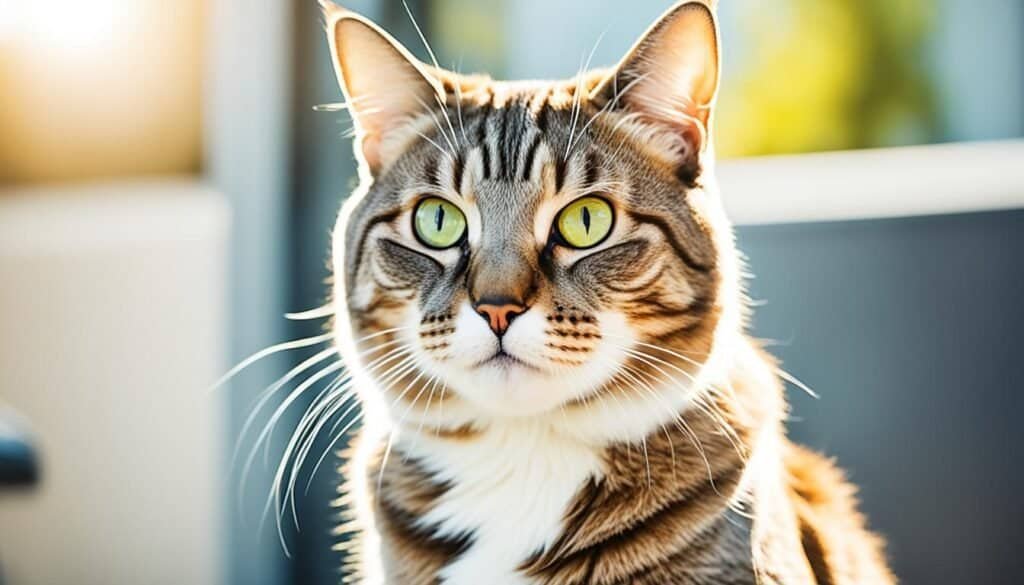
Risks of Underweight and Overweight Cats
Both underweight and overweight cats face significant risks to their health and well-being. Let’s explore the potential challenges associated with these conditions:
Risks of Underweight Cats
Underweight cats are at risk of experiencing malnutrition and a weakened immune system. These cats often lack the necessary nutrients to support their bodily functions, leading to a range of health issues. Malnutrition can weaken their immune system, making them more susceptible to infections and diseases.
Risks of Overweight Cats
On the other end of the spectrum, overweight cats are prone to obesity-related health issues. Carrying excess weight puts strain on their joints, increasing the risk of arthritis and mobility problems. Obesity is also linked to diabetes, as excessive fat tissue can interfere with insulin production and utilization. Additionally, overweight cats may face difficulties grooming themselves properly, leading to skin and coat problems.
It is essential to note that maintaining a healthy weight for cats is crucial to their overall wellness and longevity. Finding the right balance is key in ensuring their well-being.
| Underweight Cats | Overweight Cats |
|---|---|
| Experiences malnutrition | Increased risk of arthritis |
| Weakened immune system | Potential for diabetes |
| Difficulty grooming properly |
Cat Weight Management Tips for Healthy Weight
Managing your cat’s weight is crucial for their overall health and well-being. Implementing the following strategies can help promote and maintain a healthy weight for your feline friend:
- Weekly weigh-ins: Regularly monitoring your cat’s weight can help you track their progress and make necessary adjustments to their diet and exercise routine.
- Portion control: Measuring your cat’s meals and controlling their portions is essential for effective weight management. Consult with your veterinarian to determine the appropriate amount of food to feed your cat.
- Regular exercise: Encourage your cat to stay active through interactive play sessions. Engaging in 30-60 minutes of exercise a day can help them burn calories and maintain a healthy weight.
- Monitoring treats: Limiting or monitoring your cat’s treat intake is important to prevent excessive calorie consumption. Opt for low-calorie treats or use their regular kibble as a treat alternative.
By incorporating these tips into your cat’s daily routine, you can support their weight management journey and ensure they maintain a healthy weight.

Remember, always consult with your veterinarian for personalized advice and guidance specific to your cat’s unique needs.
Importance of Healthy Nutrition
When it comes to weight management for your cat, providing them with a high-quality diet is of utmost importance. Feeding your cat nutritious food not only helps regulate their weight but also ensures their overall feline health. One excellent option to consider is the Bold by Nature raw cat food, which is specifically formulated to support weight management and contains low levels of fat and carbs.
| Benefits of Bold by Nature Raw Diet |
|---|
| 1. Balanced Nutrition: The Bold by Nature raw diet offers a perfect balance of essential nutrients, vitamins, and minerals, promoting optimal health for your cat. |
| 2. High in Protein: Cats are obligate carnivores, and protein is an essential component of their diet. The Bold by Nature raw diet provides a rich source of high-quality protein to meet your cat’s dietary needs. |
| 3. Low Levels of Fat and Carbs: Excessive fat and carbs in a cat’s diet can lead to weight gain. This raw diet ensures low levels of fat and carbs, helping your cat maintain a healthy weight. |
| 4. Natural Ingredients: Bold by Nature follows strict quality standards and uses only natural, wholesome ingredients in their raw cat food products. |
By feeding your cat Bold by Nature raw diet, you can provide them with the nutrition they need while supporting their weight management goals. Remember to consult your veterinarian before making any significant dietary changes for your cat.
How Much to Feed Your Cat?
When it comes to feeding your cat, determining the appropriate amount of food is crucial for their health and well-being. Instead of relying on their current weight, it’s important to consider their ideal weight when determining their feeding guidelines. By calculating their calorie intake based on their ideal weight, you can ensure they receive the right amount of nutrition without overfeeding or underfeeding them.
Consulting your veterinarian is essential in establishing specific feeding guidelines for your cat. They can provide personalized recommendations based on factors such as breed, age, activity level, and overall health. Your veterinarian will help you determine the ideal weight for your cat and set a feeding schedule that best suits their needs.
Keep in mind that every cat is unique, and their ideal weight and feeding requirements may vary. It’s important to monitor their body condition regularly and adjust their calorie intake accordingly to maintain a healthy weight. Regular weigh-ins and body condition assessments can help you track their progress and make any necessary adjustments to their diet.
Feeding Guidelines
Feeding guidelines for cats typically recommend a certain number of calories per day based on their ideal weight. These guidelines can provide a useful starting point but should be adjusted to meet your cat’s specific needs. The following table offers a general idea of the daily caloric intake for cats based on their ideal weight:
| Ideal Weight | Daily Caloric Intake |
|---|---|
| 8 pounds | 180-200 calories |
| 10 pounds | 200-225 calories |
| 12 pounds | 225-255 calories |
Remember, these values are merely guidelines, and it’s vital to consult your veterinarian for personalized recommendations. They will consider your cat’s specific needs and make appropriate adjustments to the feeding guidelines based on factors such as age, health conditions, and activity levels.
Measuring your cat’s food and controlling portions are essential for weight management. Using a digital kitchen scale or measuring cup can help ensure accuracy and prevent overfeeding. Dividing their daily caloric intake into multiple small meals throughout the day is also beneficial, as it helps regulate their metabolism and prevents excessive hunger between meals.
By following proper feeding guidelines, you can help your cat maintain a healthy weight and promote their overall well-being.
Conclusion
Maintaining a healthy weight for your cat is crucial for their overall well-being. Implementing key elements such as regular veterinary check-ups, proper nutrition, portion control, regular exercise, and monitoring treats are essential for successful cat weight management.
A holistic approach to cat weight management is highly recommended. Consulting with a holistic veterinarian can provide you with valuable insights and guidance tailored to your cat’s specific needs. Holistic veterinarians focus on the well-being of the whole cat, considering not only physical health but also emotional and environmental factors.
When it comes to nutrition, consider incorporating Bold by Nature’s raw cat food diet into your feline companion’s meals. Bold by Nature products offer a natural and nutritious option with low levels of fat and carbs, supporting weight regulation and providing essential nutrients for your cat’s optimal health.
FAQ
Why is it important to consult a veterinarian before starting a weight-loss journey for my cat?
How can I measure my cat’s meals and control portions?
What kind of food should I feed my cat for weight management?
How can I get my cat to exercise?
What should I know about feeding my cat treats?
How do I determine a healthy weight for my cat?
What are the risks of having an underweight or overweight cat?
What are some tips for managing my cat’s weight?
How important is nutrition for cat weight management?
How much should I feed my cat?
What are the key elements in successful cat weight management?
Last modified: February 20, 2024


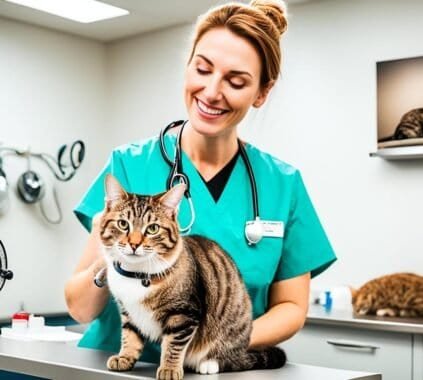
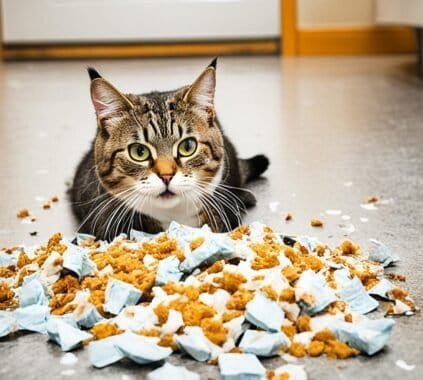



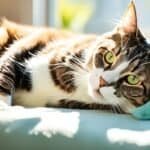
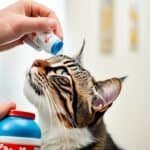

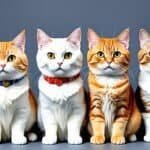
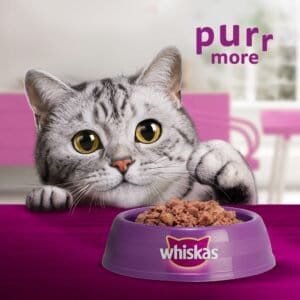

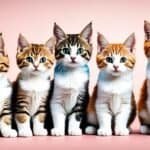
[…] suspected spinal injury: If there is a possibility of spinal injury, it’s essential to handle the cat with extra care. Placing the injured cat in a large box can provide stability and minimize further […]
[…] consult with your veterinarian. They can provide guidance on determining the ideal weight for your cat and creating a customized weight management plan. This may involve adjusting portion sizes or switching to a specially formulated senior cat […]
[…] concerns about the use of anesthesia during the dental cleaning procedure. However, anesthesia is essential to ensure the safety and comfort of the cat throughout the process. Veterinarians take all necessary precautions and tailor the anesthesia […]
[…] visits to the veterinarian are essential in managing cat parasites. During these visits, the veterinarian will assess your cat’s overall health and […]
[…] detection and treatment are essential in managing heartworm in cats. Veterinarians can perform diagnostic tests to confirm the presence of heartworm and recommend […]
[…] it comes to cat weight management, it’s essential to follow feeding guidelines established by veterinarians. These guidelines […]
[…] dental care for cats is essential for their overall health and well-being. It not only helps maintain their oral health but also has […]
[…] the cat’s weight and […]
[…] cats in heat often exhibit spraying and marking behaviors, which can be disruptive and difficult to manage for both cat owners and communities. Neutered male cats are less likely to engage in aggressive behaviors and […]
[…] boosters are an essential part of maintaining your cat’s overall health and well-being. By staying up-to-date with their vaccinations, you can help ensure a […]